Leadership Practices, Challenges, and Development in BHP Group Limited
VerifiedAdded on 2023/01/07
|12
|3194
|83
Report
AI Summary
This report provides a comprehensive analysis of leadership practices within BHP Group Limited, an Anglo-Australian multinational mining, metal, and petroleum company. The report begins with an introduction to leadership, emphasizing its importance in achieving organizational goals. It then details BHP's core business activities, including mining of copper, iron ore, and coal, as well as its petroleum segment. The report explores various leadership practices at BHP, such as focusing on global objectives and inspiring a shared vision. It examines the participative leadership style practiced at BHP, where all members participate in decision-making. The report also identifies leadership challenges, including over-control, inspiring others, and developing employees. Furthermore, it discusses leadership development activities within the organization, including interactive programs and hands-on frameworks. The report analyzes the strengths and weaknesses of identified leadership practices and assesses their impact on BHP's performance. Finally, the report offers recommendations based on the analysis and concludes with a summary of the key findings.

Leadership Paper
Paraphrase This Document
Need a fresh take? Get an instant paraphrase of this document with our AI Paraphraser
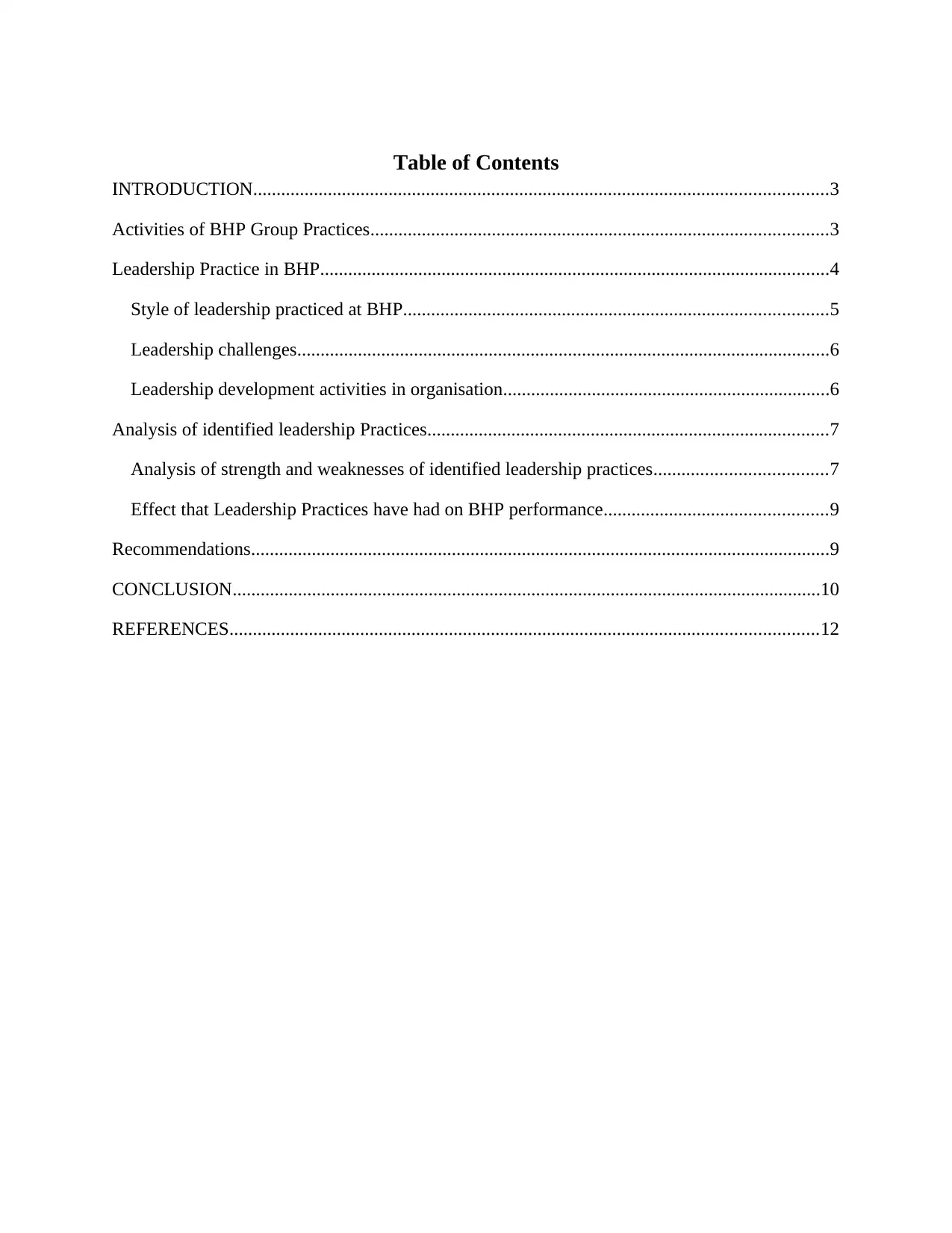
Table of Contents
INTRODUCTION...........................................................................................................................3
Activities of BHP Group Practices..................................................................................................3
Leadership Practice in BHP.............................................................................................................4
Style of leadership practiced at BHP...........................................................................................5
Leadership challenges..................................................................................................................6
Leadership development activities in organisation......................................................................6
Analysis of identified leadership Practices......................................................................................7
Analysis of strength and weaknesses of identified leadership practices.....................................7
Effect that Leadership Practices have had on BHP performance................................................9
Recommendations............................................................................................................................9
CONCLUSION..............................................................................................................................10
REFERENCES..............................................................................................................................12
INTRODUCTION...........................................................................................................................3
Activities of BHP Group Practices..................................................................................................3
Leadership Practice in BHP.............................................................................................................4
Style of leadership practiced at BHP...........................................................................................5
Leadership challenges..................................................................................................................6
Leadership development activities in organisation......................................................................6
Analysis of identified leadership Practices......................................................................................7
Analysis of strength and weaknesses of identified leadership practices.....................................7
Effect that Leadership Practices have had on BHP performance................................................9
Recommendations............................................................................................................................9
CONCLUSION..............................................................................................................................10
REFERENCES..............................................................................................................................12
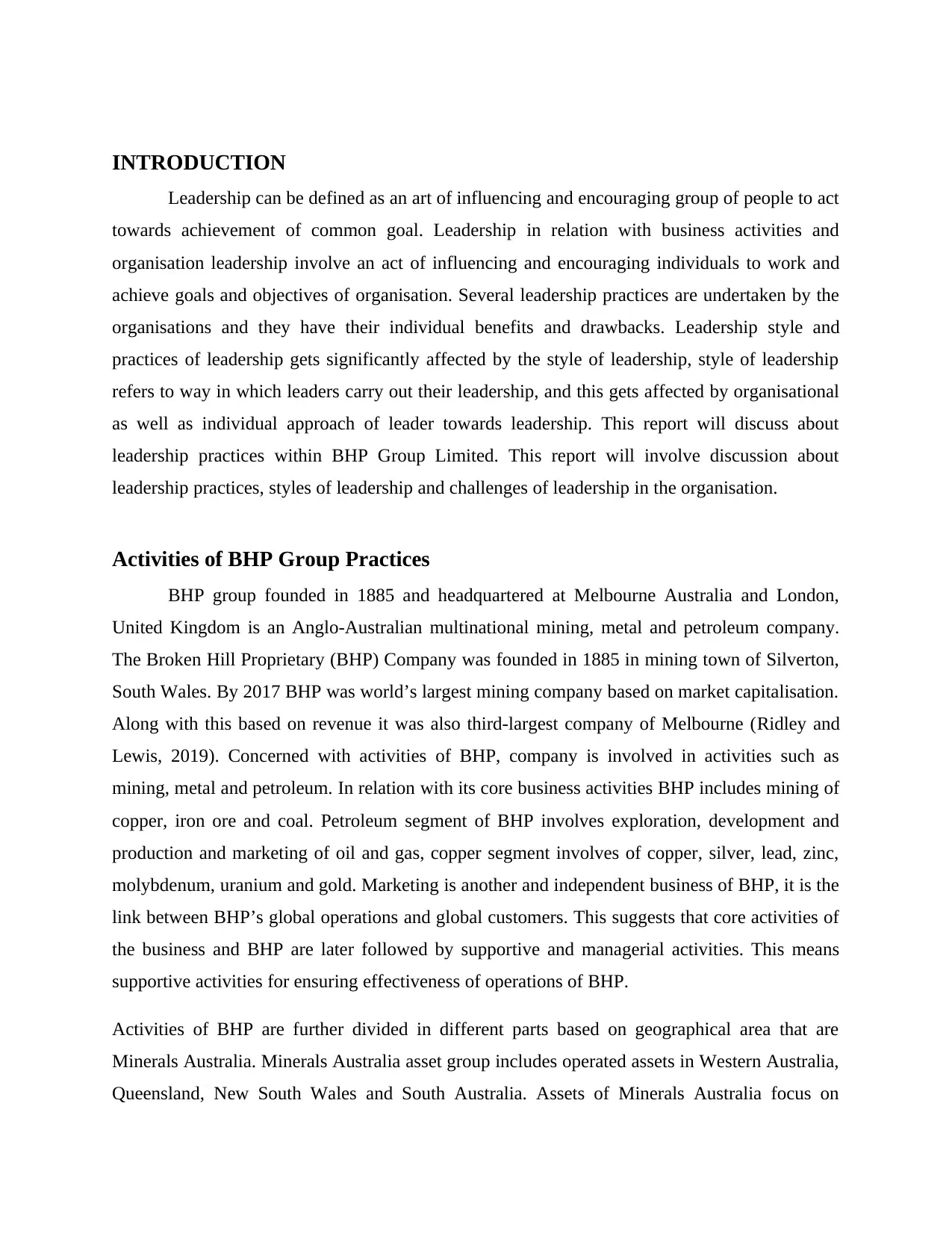
INTRODUCTION
Leadership can be defined as an art of influencing and encouraging group of people to act
towards achievement of common goal. Leadership in relation with business activities and
organisation leadership involve an act of influencing and encouraging individuals to work and
achieve goals and objectives of organisation. Several leadership practices are undertaken by the
organisations and they have their individual benefits and drawbacks. Leadership style and
practices of leadership gets significantly affected by the style of leadership, style of leadership
refers to way in which leaders carry out their leadership, and this gets affected by organisational
as well as individual approach of leader towards leadership. This report will discuss about
leadership practices within BHP Group Limited. This report will involve discussion about
leadership practices, styles of leadership and challenges of leadership in the organisation.
Activities of BHP Group Practices
BHP group founded in 1885 and headquartered at Melbourne Australia and London,
United Kingdom is an Anglo-Australian multinational mining, metal and petroleum company.
The Broken Hill Proprietary (BHP) Company was founded in 1885 in mining town of Silverton,
South Wales. By 2017 BHP was world’s largest mining company based on market capitalisation.
Along with this based on revenue it was also third-largest company of Melbourne (Ridley and
Lewis, 2019). Concerned with activities of BHP, company is involved in activities such as
mining, metal and petroleum. In relation with its core business activities BHP includes mining of
copper, iron ore and coal. Petroleum segment of BHP involves exploration, development and
production and marketing of oil and gas, copper segment involves of copper, silver, lead, zinc,
molybdenum, uranium and gold. Marketing is another and independent business of BHP, it is the
link between BHP’s global operations and global customers. This suggests that core activities of
the business and BHP are later followed by supportive and managerial activities. This means
supportive activities for ensuring effectiveness of operations of BHP.
Activities of BHP are further divided in different parts based on geographical area that are
Minerals Australia. Minerals Australia asset group includes operated assets in Western Australia,
Queensland, New South Wales and South Australia. Assets of Minerals Australia focus on
Leadership can be defined as an art of influencing and encouraging group of people to act
towards achievement of common goal. Leadership in relation with business activities and
organisation leadership involve an act of influencing and encouraging individuals to work and
achieve goals and objectives of organisation. Several leadership practices are undertaken by the
organisations and they have their individual benefits and drawbacks. Leadership style and
practices of leadership gets significantly affected by the style of leadership, style of leadership
refers to way in which leaders carry out their leadership, and this gets affected by organisational
as well as individual approach of leader towards leadership. This report will discuss about
leadership practices within BHP Group Limited. This report will involve discussion about
leadership practices, styles of leadership and challenges of leadership in the organisation.
Activities of BHP Group Practices
BHP group founded in 1885 and headquartered at Melbourne Australia and London,
United Kingdom is an Anglo-Australian multinational mining, metal and petroleum company.
The Broken Hill Proprietary (BHP) Company was founded in 1885 in mining town of Silverton,
South Wales. By 2017 BHP was world’s largest mining company based on market capitalisation.
Along with this based on revenue it was also third-largest company of Melbourne (Ridley and
Lewis, 2019). Concerned with activities of BHP, company is involved in activities such as
mining, metal and petroleum. In relation with its core business activities BHP includes mining of
copper, iron ore and coal. Petroleum segment of BHP involves exploration, development and
production and marketing of oil and gas, copper segment involves of copper, silver, lead, zinc,
molybdenum, uranium and gold. Marketing is another and independent business of BHP, it is the
link between BHP’s global operations and global customers. This suggests that core activities of
the business and BHP are later followed by supportive and managerial activities. This means
supportive activities for ensuring effectiveness of operations of BHP.
Activities of BHP are further divided in different parts based on geographical area that are
Minerals Australia. Minerals Australia asset group includes operated assets in Western Australia,
Queensland, New South Wales and South Australia. Assets of Minerals Australia focus on
⊘ This is a preview!⊘
Do you want full access?
Subscribe today to unlock all pages.

Trusted by 1+ million students worldwide
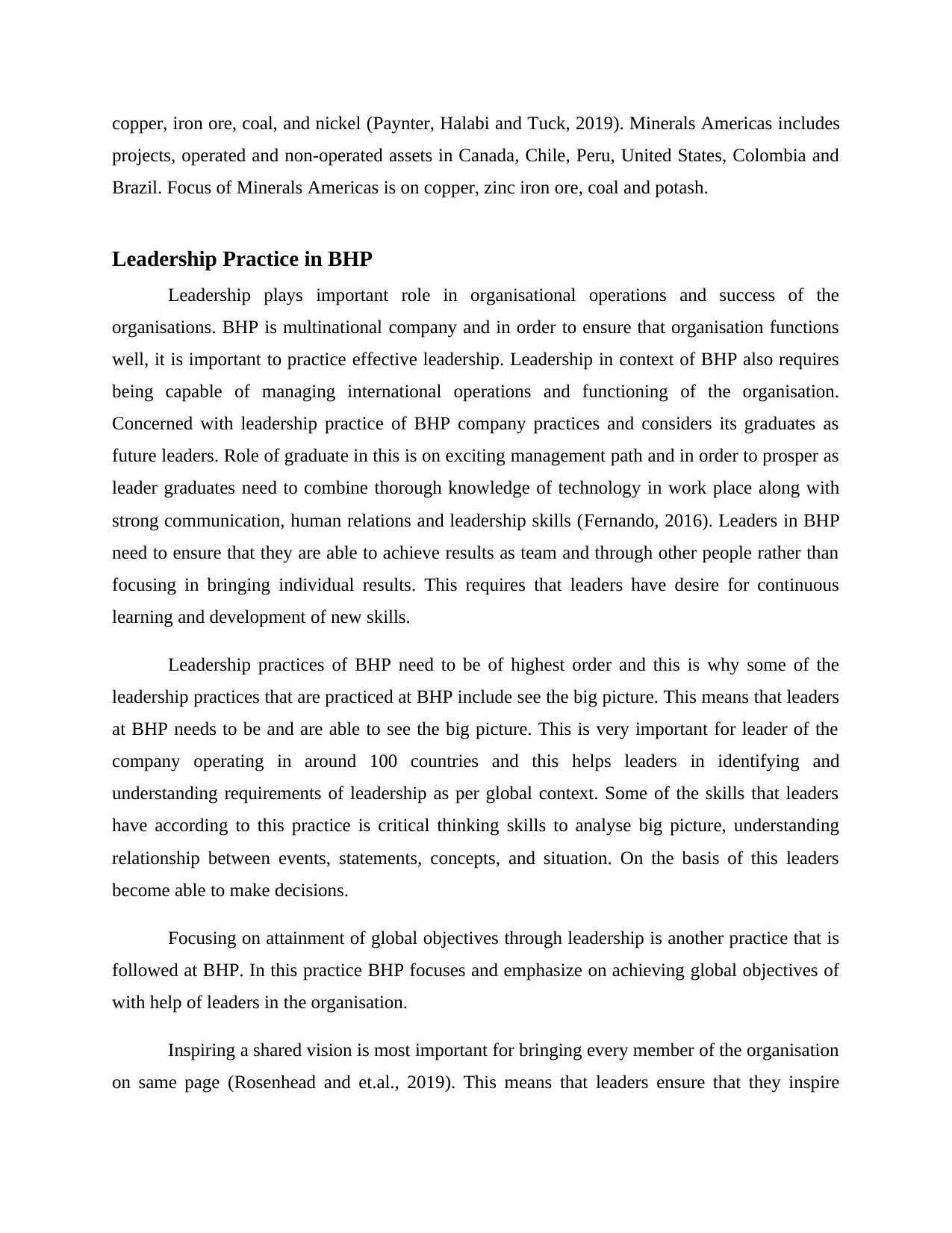
copper, iron ore, coal, and nickel (Paynter, Halabi and Tuck, 2019). Minerals Americas includes
projects, operated and non-operated assets in Canada, Chile, Peru, United States, Colombia and
Brazil. Focus of Minerals Americas is on copper, zinc iron ore, coal and potash.
Leadership Practice in BHP
Leadership plays important role in organisational operations and success of the
organisations. BHP is multinational company and in order to ensure that organisation functions
well, it is important to practice effective leadership. Leadership in context of BHP also requires
being capable of managing international operations and functioning of the organisation.
Concerned with leadership practice of BHP company practices and considers its graduates as
future leaders. Role of graduate in this is on exciting management path and in order to prosper as
leader graduates need to combine thorough knowledge of technology in work place along with
strong communication, human relations and leadership skills (Fernando, 2016). Leaders in BHP
need to ensure that they are able to achieve results as team and through other people rather than
focusing in bringing individual results. This requires that leaders have desire for continuous
learning and development of new skills.
Leadership practices of BHP need to be of highest order and this is why some of the
leadership practices that are practiced at BHP include see the big picture. This means that leaders
at BHP needs to be and are able to see the big picture. This is very important for leader of the
company operating in around 100 countries and this helps leaders in identifying and
understanding requirements of leadership as per global context. Some of the skills that leaders
have according to this practice is critical thinking skills to analyse big picture, understanding
relationship between events, statements, concepts, and situation. On the basis of this leaders
become able to make decisions.
Focusing on attainment of global objectives through leadership is another practice that is
followed at BHP. In this practice BHP focuses and emphasize on achieving global objectives of
with help of leaders in the organisation.
Inspiring a shared vision is most important for bringing every member of the organisation
on same page (Rosenhead and et.al., 2019). This means that leaders ensure that they inspire
projects, operated and non-operated assets in Canada, Chile, Peru, United States, Colombia and
Brazil. Focus of Minerals Americas is on copper, zinc iron ore, coal and potash.
Leadership Practice in BHP
Leadership plays important role in organisational operations and success of the
organisations. BHP is multinational company and in order to ensure that organisation functions
well, it is important to practice effective leadership. Leadership in context of BHP also requires
being capable of managing international operations and functioning of the organisation.
Concerned with leadership practice of BHP company practices and considers its graduates as
future leaders. Role of graduate in this is on exciting management path and in order to prosper as
leader graduates need to combine thorough knowledge of technology in work place along with
strong communication, human relations and leadership skills (Fernando, 2016). Leaders in BHP
need to ensure that they are able to achieve results as team and through other people rather than
focusing in bringing individual results. This requires that leaders have desire for continuous
learning and development of new skills.
Leadership practices of BHP need to be of highest order and this is why some of the
leadership practices that are practiced at BHP include see the big picture. This means that leaders
at BHP needs to be and are able to see the big picture. This is very important for leader of the
company operating in around 100 countries and this helps leaders in identifying and
understanding requirements of leadership as per global context. Some of the skills that leaders
have according to this practice is critical thinking skills to analyse big picture, understanding
relationship between events, statements, concepts, and situation. On the basis of this leaders
become able to make decisions.
Focusing on attainment of global objectives through leadership is another practice that is
followed at BHP. In this practice BHP focuses and emphasize on achieving global objectives of
with help of leaders in the organisation.
Inspiring a shared vision is most important for bringing every member of the organisation
on same page (Rosenhead and et.al., 2019). This means that leaders ensure that they inspire
Paraphrase This Document
Need a fresh take? Get an instant paraphrase of this document with our AI Paraphraser
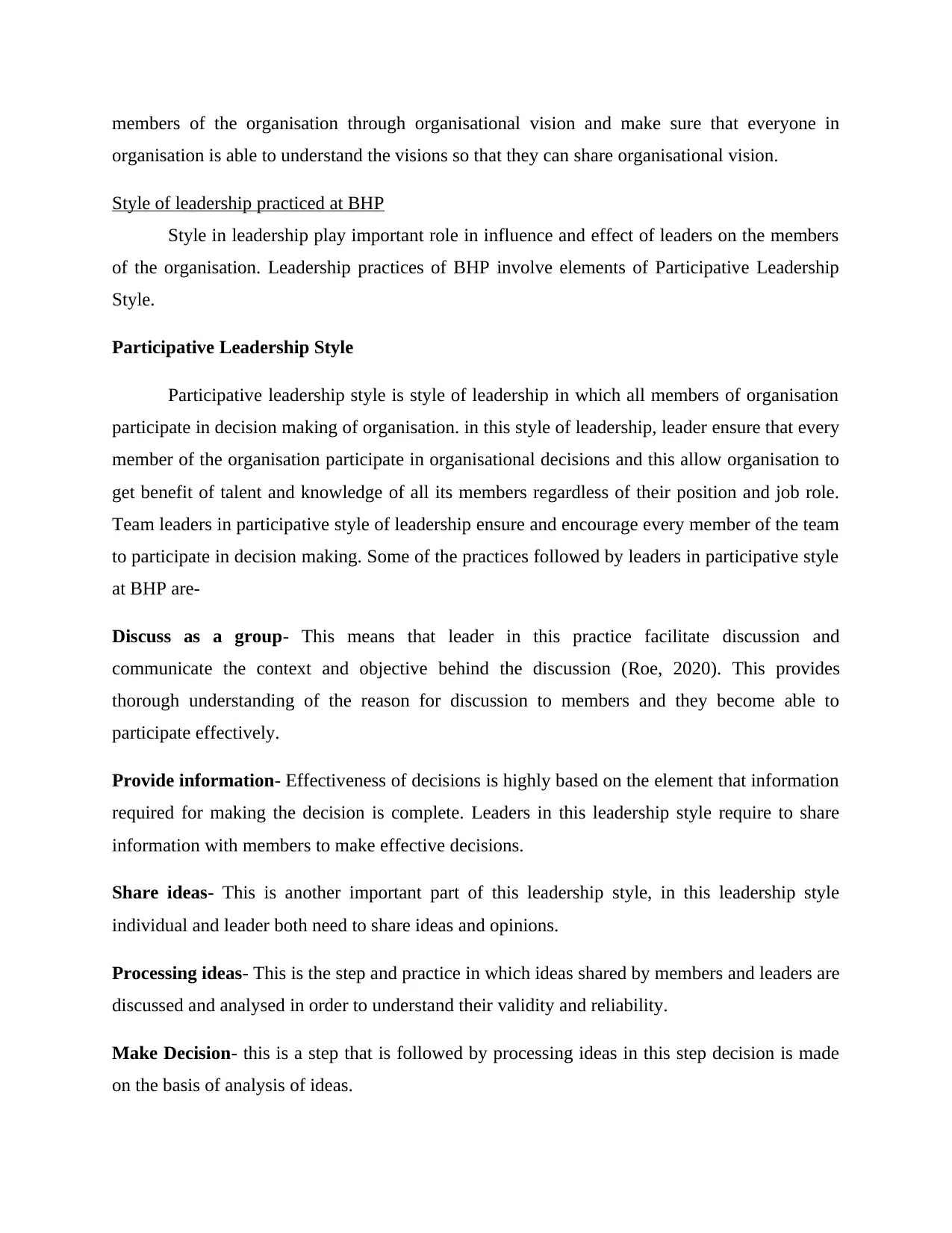
members of the organisation through organisational vision and make sure that everyone in
organisation is able to understand the visions so that they can share organisational vision.
Style of leadership practiced at BHP
Style in leadership play important role in influence and effect of leaders on the members
of the organisation. Leadership practices of BHP involve elements of Participative Leadership
Style.
Participative Leadership Style
Participative leadership style is style of leadership in which all members of organisation
participate in decision making of organisation. in this style of leadership, leader ensure that every
member of the organisation participate in organisational decisions and this allow organisation to
get benefit of talent and knowledge of all its members regardless of their position and job role.
Team leaders in participative style of leadership ensure and encourage every member of the team
to participate in decision making. Some of the practices followed by leaders in participative style
at BHP are-
Discuss as a group- This means that leader in this practice facilitate discussion and
communicate the context and objective behind the discussion (Roe, 2020). This provides
thorough understanding of the reason for discussion to members and they become able to
participate effectively.
Provide information- Effectiveness of decisions is highly based on the element that information
required for making the decision is complete. Leaders in this leadership style require to share
information with members to make effective decisions.
Share ideas- This is another important part of this leadership style, in this leadership style
individual and leader both need to share ideas and opinions.
Processing ideas- This is the step and practice in which ideas shared by members and leaders are
discussed and analysed in order to understand their validity and reliability.
Make Decision- this is a step that is followed by processing ideas in this step decision is made
on the basis of analysis of ideas.
organisation is able to understand the visions so that they can share organisational vision.
Style of leadership practiced at BHP
Style in leadership play important role in influence and effect of leaders on the members
of the organisation. Leadership practices of BHP involve elements of Participative Leadership
Style.
Participative Leadership Style
Participative leadership style is style of leadership in which all members of organisation
participate in decision making of organisation. in this style of leadership, leader ensure that every
member of the organisation participate in organisational decisions and this allow organisation to
get benefit of talent and knowledge of all its members regardless of their position and job role.
Team leaders in participative style of leadership ensure and encourage every member of the team
to participate in decision making. Some of the practices followed by leaders in participative style
at BHP are-
Discuss as a group- This means that leader in this practice facilitate discussion and
communicate the context and objective behind the discussion (Roe, 2020). This provides
thorough understanding of the reason for discussion to members and they become able to
participate effectively.
Provide information- Effectiveness of decisions is highly based on the element that information
required for making the decision is complete. Leaders in this leadership style require to share
information with members to make effective decisions.
Share ideas- This is another important part of this leadership style, in this leadership style
individual and leader both need to share ideas and opinions.
Processing ideas- This is the step and practice in which ideas shared by members and leaders are
discussed and analysed in order to understand their validity and reliability.
Make Decision- this is a step that is followed by processing ideas in this step decision is made
on the basis of analysis of ideas.
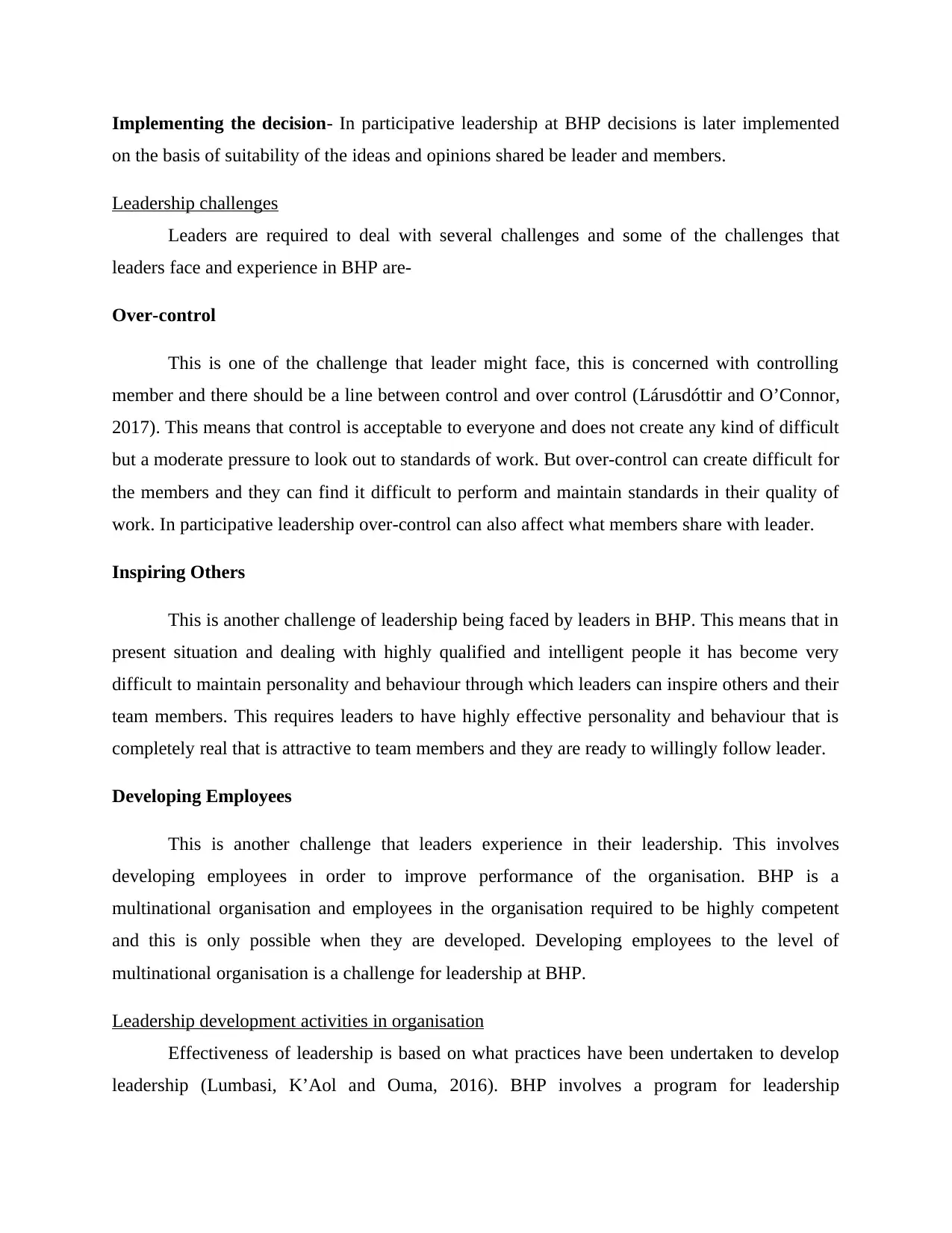
Implementing the decision- In participative leadership at BHP decisions is later implemented
on the basis of suitability of the ideas and opinions shared be leader and members.
Leadership challenges
Leaders are required to deal with several challenges and some of the challenges that
leaders face and experience in BHP are-
Over-control
This is one of the challenge that leader might face, this is concerned with controlling
member and there should be a line between control and over control (Lárusdóttir and O’Connor,
2017). This means that control is acceptable to everyone and does not create any kind of difficult
but a moderate pressure to look out to standards of work. But over-control can create difficult for
the members and they can find it difficult to perform and maintain standards in their quality of
work. In participative leadership over-control can also affect what members share with leader.
Inspiring Others
This is another challenge of leadership being faced by leaders in BHP. This means that in
present situation and dealing with highly qualified and intelligent people it has become very
difficult to maintain personality and behaviour through which leaders can inspire others and their
team members. This requires leaders to have highly effective personality and behaviour that is
completely real that is attractive to team members and they are ready to willingly follow leader.
Developing Employees
This is another challenge that leaders experience in their leadership. This involves
developing employees in order to improve performance of the organisation. BHP is a
multinational organisation and employees in the organisation required to be highly competent
and this is only possible when they are developed. Developing employees to the level of
multinational organisation is a challenge for leadership at BHP.
Leadership development activities in organisation
Effectiveness of leadership is based on what practices have been undertaken to develop
leadership (Lumbasi, K’Aol and Ouma, 2016). BHP involves a program for leadership
on the basis of suitability of the ideas and opinions shared be leader and members.
Leadership challenges
Leaders are required to deal with several challenges and some of the challenges that
leaders face and experience in BHP are-
Over-control
This is one of the challenge that leader might face, this is concerned with controlling
member and there should be a line between control and over control (Lárusdóttir and O’Connor,
2017). This means that control is acceptable to everyone and does not create any kind of difficult
but a moderate pressure to look out to standards of work. But over-control can create difficult for
the members and they can find it difficult to perform and maintain standards in their quality of
work. In participative leadership over-control can also affect what members share with leader.
Inspiring Others
This is another challenge of leadership being faced by leaders in BHP. This means that in
present situation and dealing with highly qualified and intelligent people it has become very
difficult to maintain personality and behaviour through which leaders can inspire others and their
team members. This requires leaders to have highly effective personality and behaviour that is
completely real that is attractive to team members and they are ready to willingly follow leader.
Developing Employees
This is another challenge that leaders experience in their leadership. This involves
developing employees in order to improve performance of the organisation. BHP is a
multinational organisation and employees in the organisation required to be highly competent
and this is only possible when they are developed. Developing employees to the level of
multinational organisation is a challenge for leadership at BHP.
Leadership development activities in organisation
Effectiveness of leadership is based on what practices have been undertaken to develop
leadership (Lumbasi, K’Aol and Ouma, 2016). BHP involves a program for leadership
⊘ This is a preview!⊘
Do you want full access?
Subscribe today to unlock all pages.

Trusted by 1+ million students worldwide
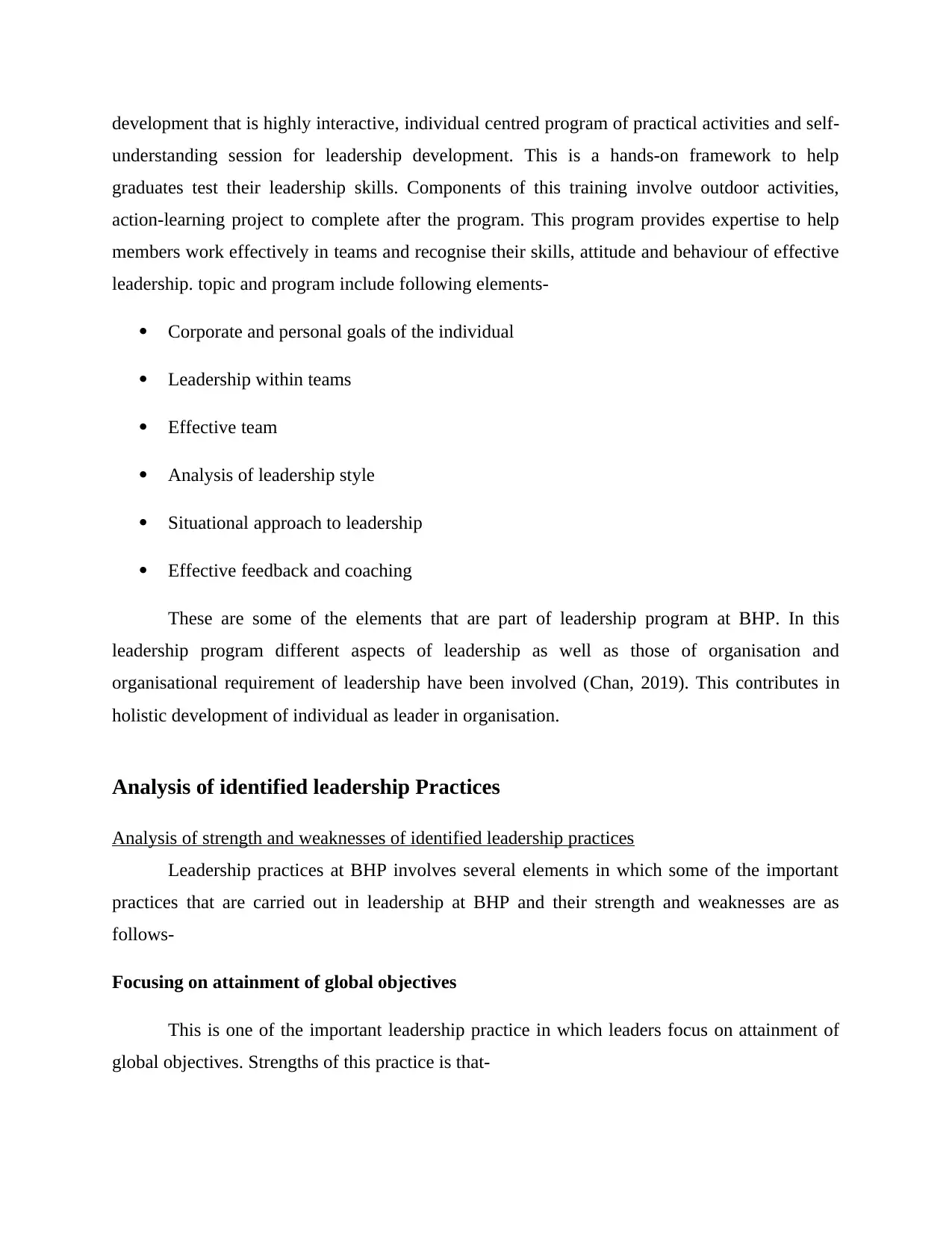
development that is highly interactive, individual centred program of practical activities and self-
understanding session for leadership development. This is a hands-on framework to help
graduates test their leadership skills. Components of this training involve outdoor activities,
action-learning project to complete after the program. This program provides expertise to help
members work effectively in teams and recognise their skills, attitude and behaviour of effective
leadership. topic and program include following elements-
Corporate and personal goals of the individual
Leadership within teams
Effective team
Analysis of leadership style
Situational approach to leadership
Effective feedback and coaching
These are some of the elements that are part of leadership program at BHP. In this
leadership program different aspects of leadership as well as those of organisation and
organisational requirement of leadership have been involved (Chan, 2019). This contributes in
holistic development of individual as leader in organisation.
Analysis of identified leadership Practices
Analysis of strength and weaknesses of identified leadership practices
Leadership practices at BHP involves several elements in which some of the important
practices that are carried out in leadership at BHP and their strength and weaknesses are as
follows-
Focusing on attainment of global objectives
This is one of the important leadership practice in which leaders focus on attainment of
global objectives. Strengths of this practice is that-
understanding session for leadership development. This is a hands-on framework to help
graduates test their leadership skills. Components of this training involve outdoor activities,
action-learning project to complete after the program. This program provides expertise to help
members work effectively in teams and recognise their skills, attitude and behaviour of effective
leadership. topic and program include following elements-
Corporate and personal goals of the individual
Leadership within teams
Effective team
Analysis of leadership style
Situational approach to leadership
Effective feedback and coaching
These are some of the elements that are part of leadership program at BHP. In this
leadership program different aspects of leadership as well as those of organisation and
organisational requirement of leadership have been involved (Chan, 2019). This contributes in
holistic development of individual as leader in organisation.
Analysis of identified leadership Practices
Analysis of strength and weaknesses of identified leadership practices
Leadership practices at BHP involves several elements in which some of the important
practices that are carried out in leadership at BHP and their strength and weaknesses are as
follows-
Focusing on attainment of global objectives
This is one of the important leadership practice in which leaders focus on attainment of
global objectives. Strengths of this practice is that-
Paraphrase This Document
Need a fresh take? Get an instant paraphrase of this document with our AI Paraphraser
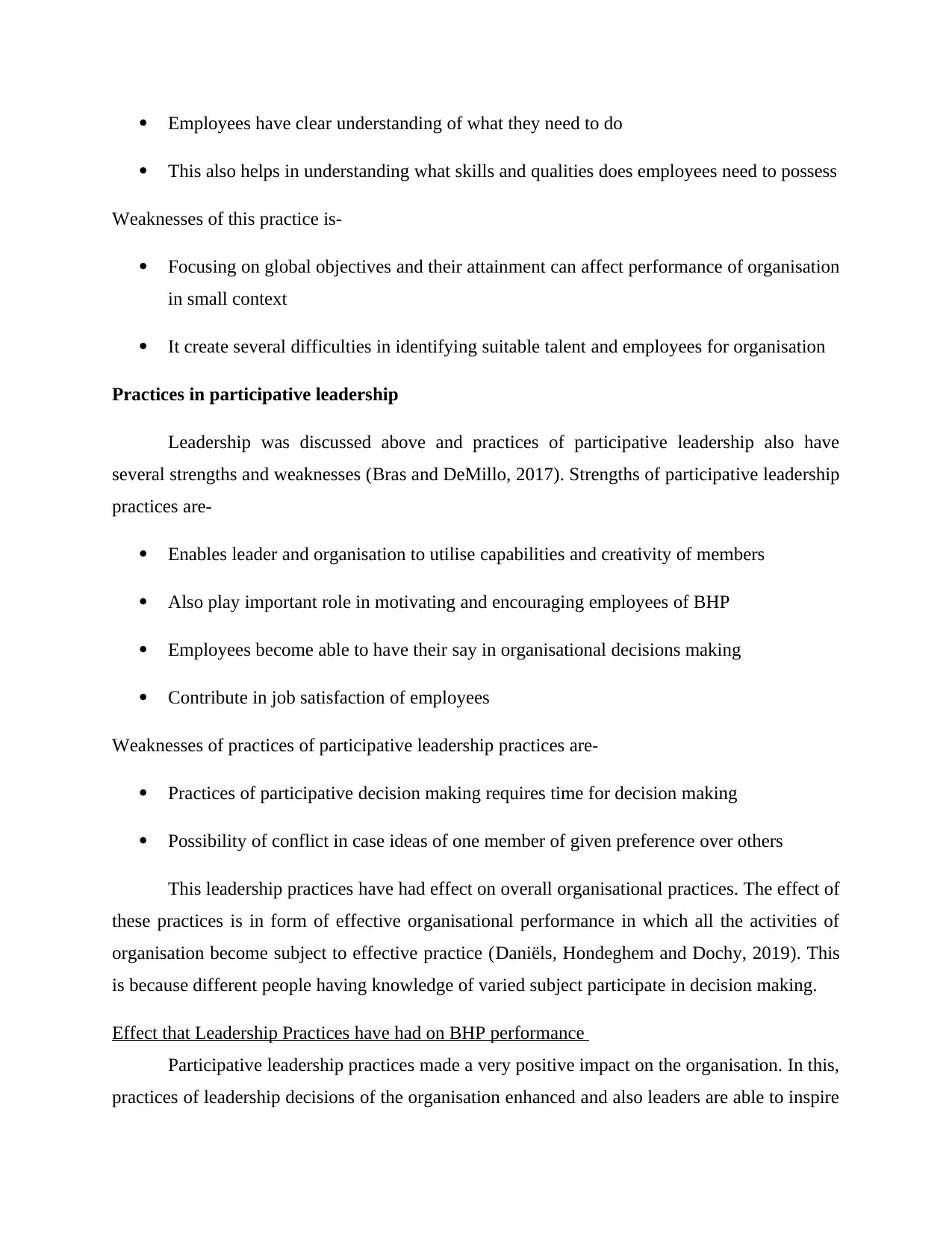
Employees have clear understanding of what they need to do
This also helps in understanding what skills and qualities does employees need to possess
Weaknesses of this practice is-
Focusing on global objectives and their attainment can affect performance of organisation
in small context
It create several difficulties in identifying suitable talent and employees for organisation
Practices in participative leadership
Leadership was discussed above and practices of participative leadership also have
several strengths and weaknesses (Bras and DeMillo, 2017). Strengths of participative leadership
practices are-
Enables leader and organisation to utilise capabilities and creativity of members
Also play important role in motivating and encouraging employees of BHP
Employees become able to have their say in organisational decisions making
Contribute in job satisfaction of employees
Weaknesses of practices of participative leadership practices are-
Practices of participative decision making requires time for decision making
Possibility of conflict in case ideas of one member of given preference over others
This leadership practices have had effect on overall organisational practices. The effect of
these practices is in form of effective organisational performance in which all the activities of
organisation become subject to effective practice (Daniëls, Hondeghem and Dochy, 2019). This
is because different people having knowledge of varied subject participate in decision making.
Effect that Leadership Practices have had on BHP performance
Participative leadership practices made a very positive impact on the organisation. In this,
practices of leadership decisions of the organisation enhanced and also leaders are able to inspire
This also helps in understanding what skills and qualities does employees need to possess
Weaknesses of this practice is-
Focusing on global objectives and their attainment can affect performance of organisation
in small context
It create several difficulties in identifying suitable talent and employees for organisation
Practices in participative leadership
Leadership was discussed above and practices of participative leadership also have
several strengths and weaknesses (Bras and DeMillo, 2017). Strengths of participative leadership
practices are-
Enables leader and organisation to utilise capabilities and creativity of members
Also play important role in motivating and encouraging employees of BHP
Employees become able to have their say in organisational decisions making
Contribute in job satisfaction of employees
Weaknesses of practices of participative leadership practices are-
Practices of participative decision making requires time for decision making
Possibility of conflict in case ideas of one member of given preference over others
This leadership practices have had effect on overall organisational practices. The effect of
these practices is in form of effective organisational performance in which all the activities of
organisation become subject to effective practice (Daniëls, Hondeghem and Dochy, 2019). This
is because different people having knowledge of varied subject participate in decision making.
Effect that Leadership Practices have had on BHP performance
Participative leadership practices made a very positive impact on the organisation. In this,
practices of leadership decisions of the organisation enhanced and also leaders are able to inspire
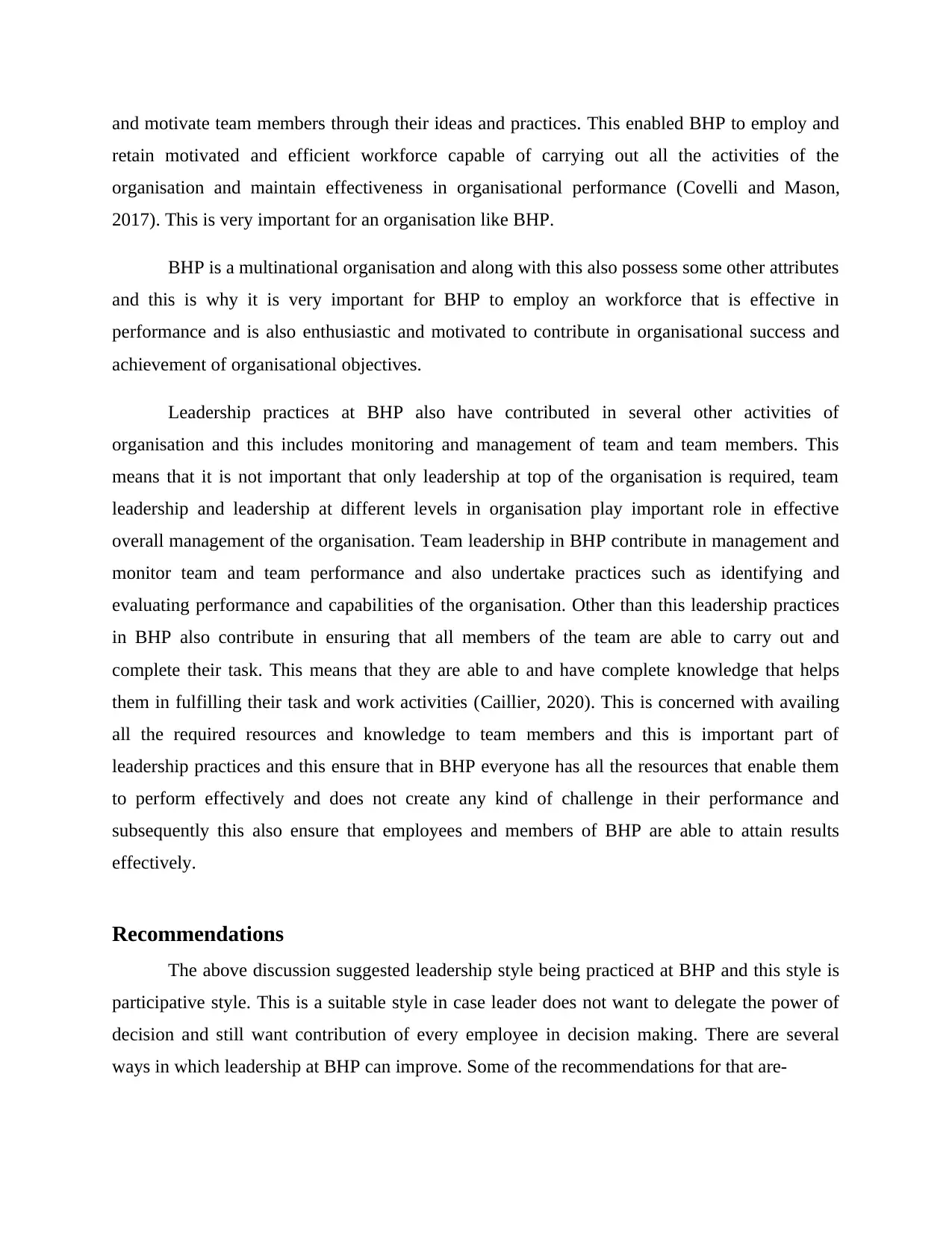
and motivate team members through their ideas and practices. This enabled BHP to employ and
retain motivated and efficient workforce capable of carrying out all the activities of the
organisation and maintain effectiveness in organisational performance (Covelli and Mason,
2017). This is very important for an organisation like BHP.
BHP is a multinational organisation and along with this also possess some other attributes
and this is why it is very important for BHP to employ an workforce that is effective in
performance and is also enthusiastic and motivated to contribute in organisational success and
achievement of organisational objectives.
Leadership practices at BHP also have contributed in several other activities of
organisation and this includes monitoring and management of team and team members. This
means that it is not important that only leadership at top of the organisation is required, team
leadership and leadership at different levels in organisation play important role in effective
overall management of the organisation. Team leadership in BHP contribute in management and
monitor team and team performance and also undertake practices such as identifying and
evaluating performance and capabilities of the organisation. Other than this leadership practices
in BHP also contribute in ensuring that all members of the team are able to carry out and
complete their task. This means that they are able to and have complete knowledge that helps
them in fulfilling their task and work activities (Caillier, 2020). This is concerned with availing
all the required resources and knowledge to team members and this is important part of
leadership practices and this ensure that in BHP everyone has all the resources that enable them
to perform effectively and does not create any kind of challenge in their performance and
subsequently this also ensure that employees and members of BHP are able to attain results
effectively.
Recommendations
The above discussion suggested leadership style being practiced at BHP and this style is
participative style. This is a suitable style in case leader does not want to delegate the power of
decision and still want contribution of every employee in decision making. There are several
ways in which leadership at BHP can improve. Some of the recommendations for that are-
retain motivated and efficient workforce capable of carrying out all the activities of the
organisation and maintain effectiveness in organisational performance (Covelli and Mason,
2017). This is very important for an organisation like BHP.
BHP is a multinational organisation and along with this also possess some other attributes
and this is why it is very important for BHP to employ an workforce that is effective in
performance and is also enthusiastic and motivated to contribute in organisational success and
achievement of organisational objectives.
Leadership practices at BHP also have contributed in several other activities of
organisation and this includes monitoring and management of team and team members. This
means that it is not important that only leadership at top of the organisation is required, team
leadership and leadership at different levels in organisation play important role in effective
overall management of the organisation. Team leadership in BHP contribute in management and
monitor team and team performance and also undertake practices such as identifying and
evaluating performance and capabilities of the organisation. Other than this leadership practices
in BHP also contribute in ensuring that all members of the team are able to carry out and
complete their task. This means that they are able to and have complete knowledge that helps
them in fulfilling their task and work activities (Caillier, 2020). This is concerned with availing
all the required resources and knowledge to team members and this is important part of
leadership practices and this ensure that in BHP everyone has all the resources that enable them
to perform effectively and does not create any kind of challenge in their performance and
subsequently this also ensure that employees and members of BHP are able to attain results
effectively.
Recommendations
The above discussion suggested leadership style being practiced at BHP and this style is
participative style. This is a suitable style in case leader does not want to delegate the power of
decision and still want contribution of every employee in decision making. There are several
ways in which leadership at BHP can improve. Some of the recommendations for that are-
⊘ This is a preview!⊘
Do you want full access?
Subscribe today to unlock all pages.

Trusted by 1+ million students worldwide
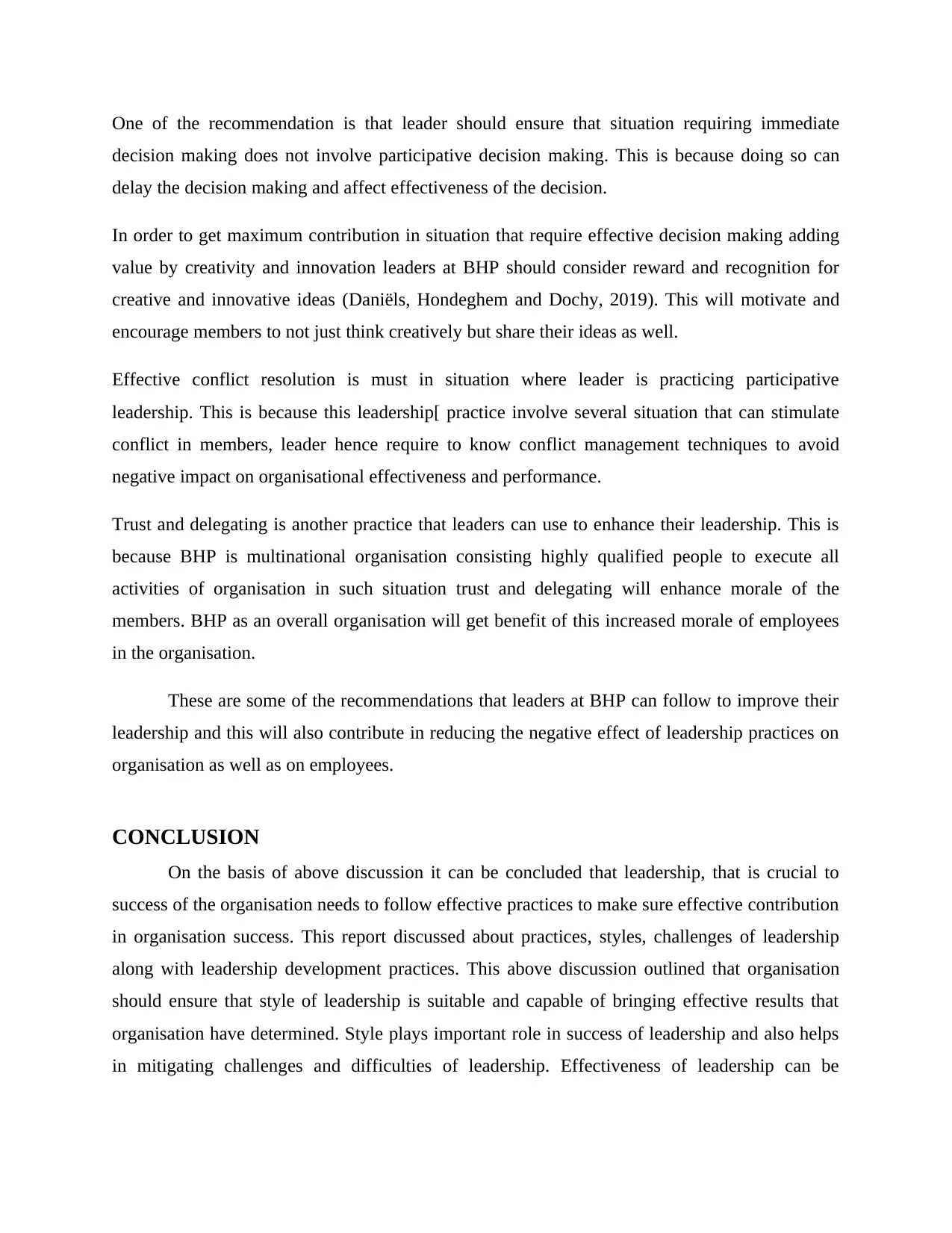
One of the recommendation is that leader should ensure that situation requiring immediate
decision making does not involve participative decision making. This is because doing so can
delay the decision making and affect effectiveness of the decision.
In order to get maximum contribution in situation that require effective decision making adding
value by creativity and innovation leaders at BHP should consider reward and recognition for
creative and innovative ideas (Daniëls, Hondeghem and Dochy, 2019). This will motivate and
encourage members to not just think creatively but share their ideas as well.
Effective conflict resolution is must in situation where leader is practicing participative
leadership. This is because this leadership[ practice involve several situation that can stimulate
conflict in members, leader hence require to know conflict management techniques to avoid
negative impact on organisational effectiveness and performance.
Trust and delegating is another practice that leaders can use to enhance their leadership. This is
because BHP is multinational organisation consisting highly qualified people to execute all
activities of organisation in such situation trust and delegating will enhance morale of the
members. BHP as an overall organisation will get benefit of this increased morale of employees
in the organisation.
These are some of the recommendations that leaders at BHP can follow to improve their
leadership and this will also contribute in reducing the negative effect of leadership practices on
organisation as well as on employees.
CONCLUSION
On the basis of above discussion it can be concluded that leadership, that is crucial to
success of the organisation needs to follow effective practices to make sure effective contribution
in organisation success. This report discussed about practices, styles, challenges of leadership
along with leadership development practices. This above discussion outlined that organisation
should ensure that style of leadership is suitable and capable of bringing effective results that
organisation have determined. Style plays important role in success of leadership and also helps
in mitigating challenges and difficulties of leadership. Effectiveness of leadership can be
decision making does not involve participative decision making. This is because doing so can
delay the decision making and affect effectiveness of the decision.
In order to get maximum contribution in situation that require effective decision making adding
value by creativity and innovation leaders at BHP should consider reward and recognition for
creative and innovative ideas (Daniëls, Hondeghem and Dochy, 2019). This will motivate and
encourage members to not just think creatively but share their ideas as well.
Effective conflict resolution is must in situation where leader is practicing participative
leadership. This is because this leadership[ practice involve several situation that can stimulate
conflict in members, leader hence require to know conflict management techniques to avoid
negative impact on organisational effectiveness and performance.
Trust and delegating is another practice that leaders can use to enhance their leadership. This is
because BHP is multinational organisation consisting highly qualified people to execute all
activities of organisation in such situation trust and delegating will enhance morale of the
members. BHP as an overall organisation will get benefit of this increased morale of employees
in the organisation.
These are some of the recommendations that leaders at BHP can follow to improve their
leadership and this will also contribute in reducing the negative effect of leadership practices on
organisation as well as on employees.
CONCLUSION
On the basis of above discussion it can be concluded that leadership, that is crucial to
success of the organisation needs to follow effective practices to make sure effective contribution
in organisation success. This report discussed about practices, styles, challenges of leadership
along with leadership development practices. This above discussion outlined that organisation
should ensure that style of leadership is suitable and capable of bringing effective results that
organisation have determined. Style plays important role in success of leadership and also helps
in mitigating challenges and difficulties of leadership. Effectiveness of leadership can be
Paraphrase This Document
Need a fresh take? Get an instant paraphrase of this document with our AI Paraphraser
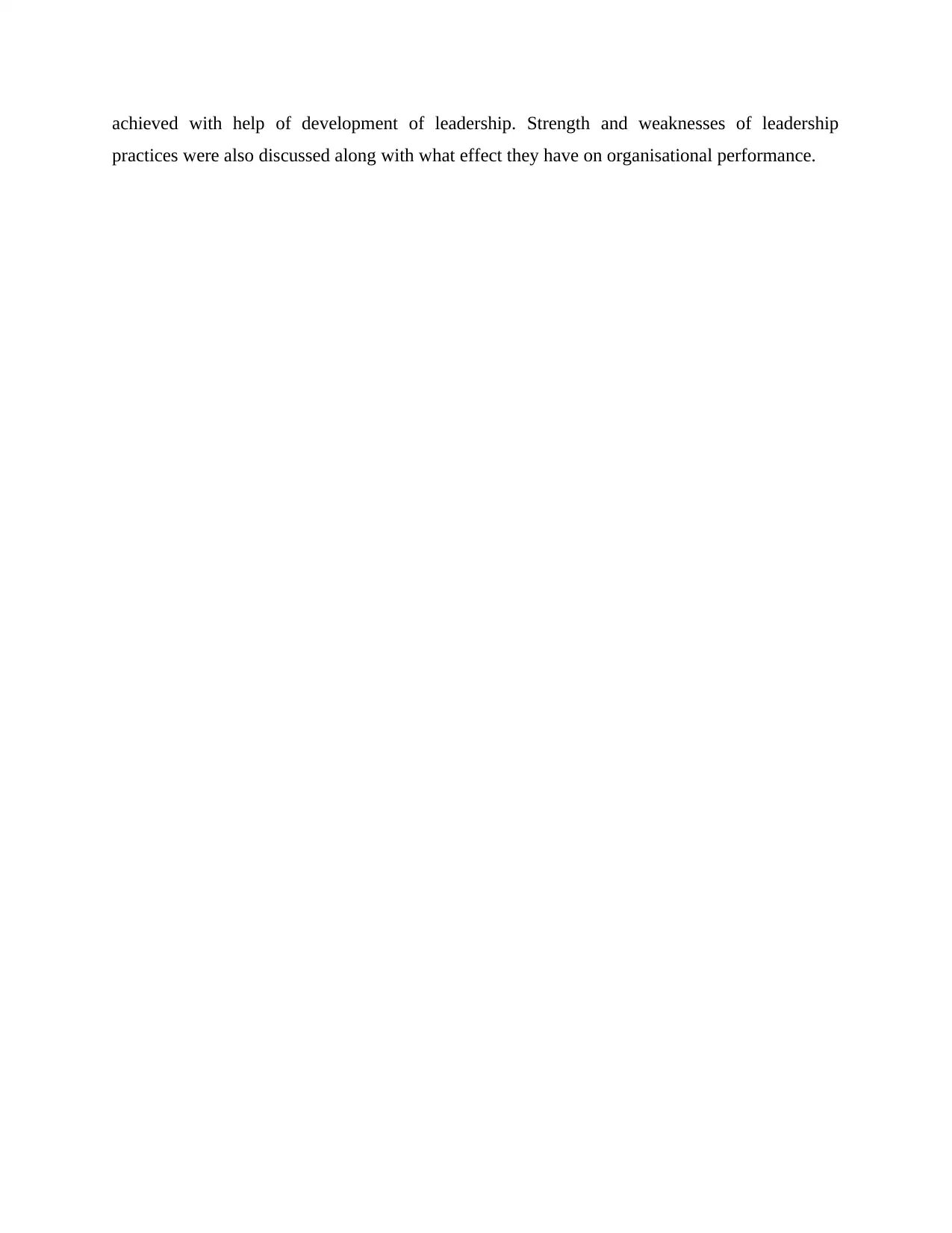
achieved with help of development of leadership. Strength and weaknesses of leadership
practices were also discussed along with what effect they have on organisational performance.
practices were also discussed along with what effect they have on organisational performance.
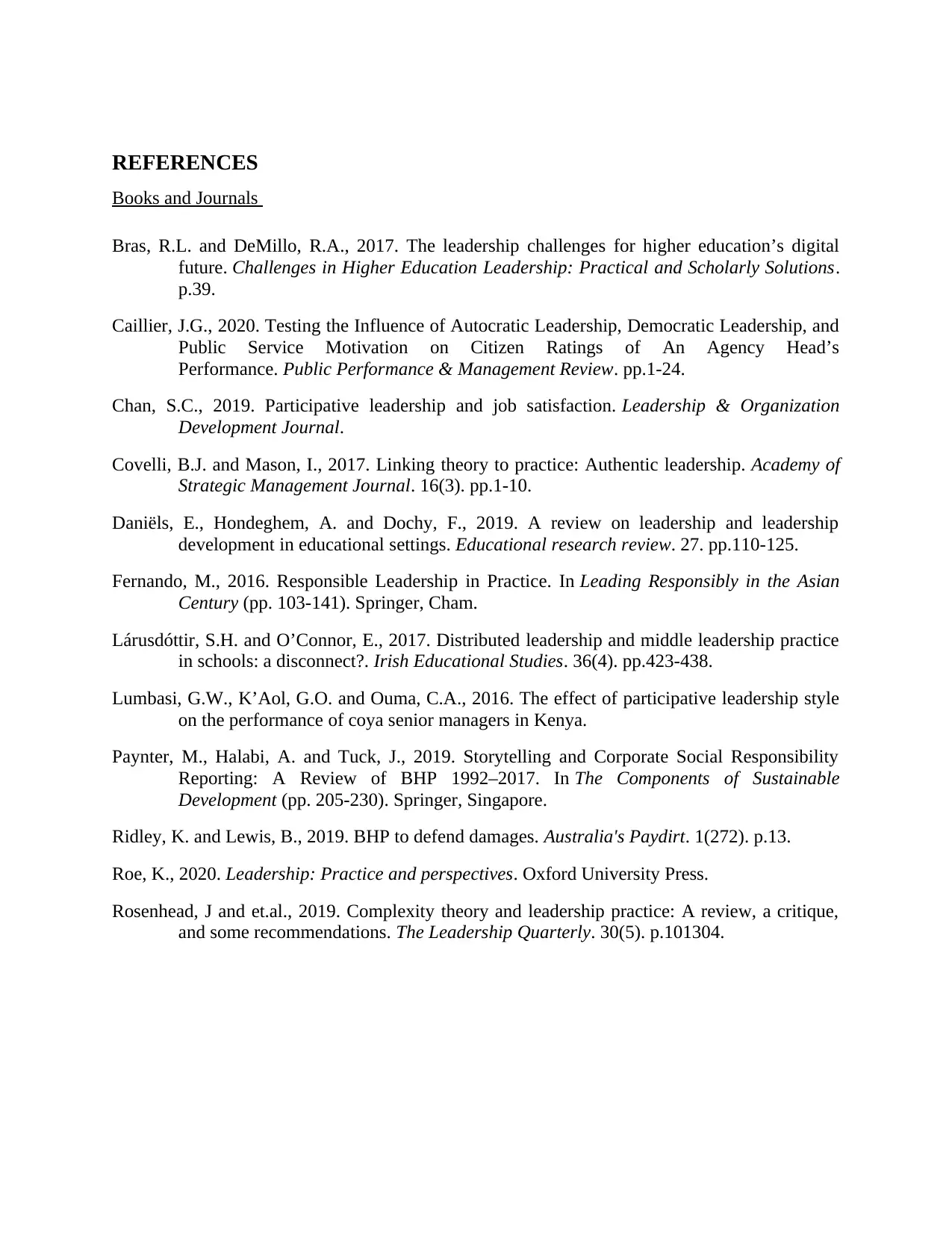
REFERENCES
Books and Journals
Bras, R.L. and DeMillo, R.A., 2017. The leadership challenges for higher education’s digital
future. Challenges in Higher Education Leadership: Practical and Scholarly Solutions.
p.39.
Caillier, J.G., 2020. Testing the Influence of Autocratic Leadership, Democratic Leadership, and
Public Service Motivation on Citizen Ratings of An Agency Head’s
Performance. Public Performance & Management Review. pp.1-24.
Chan, S.C., 2019. Participative leadership and job satisfaction. Leadership & Organization
Development Journal.
Covelli, B.J. and Mason, I., 2017. Linking theory to practice: Authentic leadership. Academy of
Strategic Management Journal. 16(3). pp.1-10.
Daniëls, E., Hondeghem, A. and Dochy, F., 2019. A review on leadership and leadership
development in educational settings. Educational research review. 27. pp.110-125.
Fernando, M., 2016. Responsible Leadership in Practice. In Leading Responsibly in the Asian
Century (pp. 103-141). Springer, Cham.
Lárusdóttir, S.H. and O’Connor, E., 2017. Distributed leadership and middle leadership practice
in schools: a disconnect?. Irish Educational Studies. 36(4). pp.423-438.
Lumbasi, G.W., K’Aol, G.O. and Ouma, C.A., 2016. The effect of participative leadership style
on the performance of coya senior managers in Kenya.
Paynter, M., Halabi, A. and Tuck, J., 2019. Storytelling and Corporate Social Responsibility
Reporting: A Review of BHP 1992–2017. In The Components of Sustainable
Development (pp. 205-230). Springer, Singapore.
Ridley, K. and Lewis, B., 2019. BHP to defend damages. Australia's Paydirt. 1(272). p.13.
Roe, K., 2020. Leadership: Practice and perspectives. Oxford University Press.
Rosenhead, J and et.al., 2019. Complexity theory and leadership practice: A review, a critique,
and some recommendations. The Leadership Quarterly. 30(5). p.101304.
Books and Journals
Bras, R.L. and DeMillo, R.A., 2017. The leadership challenges for higher education’s digital
future. Challenges in Higher Education Leadership: Practical and Scholarly Solutions.
p.39.
Caillier, J.G., 2020. Testing the Influence of Autocratic Leadership, Democratic Leadership, and
Public Service Motivation on Citizen Ratings of An Agency Head’s
Performance. Public Performance & Management Review. pp.1-24.
Chan, S.C., 2019. Participative leadership and job satisfaction. Leadership & Organization
Development Journal.
Covelli, B.J. and Mason, I., 2017. Linking theory to practice: Authentic leadership. Academy of
Strategic Management Journal. 16(3). pp.1-10.
Daniëls, E., Hondeghem, A. and Dochy, F., 2019. A review on leadership and leadership
development in educational settings. Educational research review. 27. pp.110-125.
Fernando, M., 2016. Responsible Leadership in Practice. In Leading Responsibly in the Asian
Century (pp. 103-141). Springer, Cham.
Lárusdóttir, S.H. and O’Connor, E., 2017. Distributed leadership and middle leadership practice
in schools: a disconnect?. Irish Educational Studies. 36(4). pp.423-438.
Lumbasi, G.W., K’Aol, G.O. and Ouma, C.A., 2016. The effect of participative leadership style
on the performance of coya senior managers in Kenya.
Paynter, M., Halabi, A. and Tuck, J., 2019. Storytelling and Corporate Social Responsibility
Reporting: A Review of BHP 1992–2017. In The Components of Sustainable
Development (pp. 205-230). Springer, Singapore.
Ridley, K. and Lewis, B., 2019. BHP to defend damages. Australia's Paydirt. 1(272). p.13.
Roe, K., 2020. Leadership: Practice and perspectives. Oxford University Press.
Rosenhead, J and et.al., 2019. Complexity theory and leadership practice: A review, a critique,
and some recommendations. The Leadership Quarterly. 30(5). p.101304.
⊘ This is a preview!⊘
Do you want full access?
Subscribe today to unlock all pages.

Trusted by 1+ million students worldwide
1 out of 12
Related Documents
Your All-in-One AI-Powered Toolkit for Academic Success.
+13062052269
info@desklib.com
Available 24*7 on WhatsApp / Email
![[object Object]](/_next/static/media/star-bottom.7253800d.svg)
Unlock your academic potential
Copyright © 2020–2025 A2Z Services. All Rights Reserved. Developed and managed by ZUCOL.





